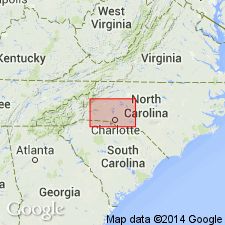
- Usage in publication:
-
- Churchland Plutonic Suite*
- Modifications:
-
- Named
- Geochronologic dating
- Dominant lithology:
-
- Granite
- AAPG geologic province:
-
- Piedmont-Blue Ridge province
Summary:
The informal Yorkville-Churchland (Western) group of plutons of Fullager and Butler (1979, Am. Jour. Science, v. 279, p. 161-185), in the Charlotte belt, NC and SC, is here named the Churchland Plutonic Suite. The name Yorkville Quartz Monzonite is here abandoned because granites previously mapped as Yorkville, including the type Yorkville near York, SC, are here assigned to the Churchland. The Suite includes the Churchland, Landis, and Gastonia plutons in Davidson, Forsyth, Rowan, Iredell, Cabarrus, and Iredell Cos., NC, and the York and Clover plutons in York Co., SC. The York and Churchland plutons are representative of the suite. They are post-metamorphic, Alleghanian-age granite plutons, part of a supersuite of post-metamorphic plutons in the southern Piedmont, ranging in age from 330 to 265 m.y. Major rock types are biotite monzogranite, typically porphyritic, but with fine-grained phases; and minor quartz monzonite and hornblende-bearing phases. Age is Pennsylvanian and Permian, based on Rb-Sr whole rock ages of 282+6 m.y. (Churchland pluton), 292+29 m.y. (Landis pluton), and 332+6 m.y. (York pluton).
Source: GNU records (USGS DDS-6; Reston GNULEX).
For more information, please contact Nancy Stamm, Geologic Names Committee Secretary.
Asterisk (*) indicates published by U.S. Geological Survey authors.
"No current usage" (†) implies that a name has been abandoned or has fallen into disuse. Former usage and, if known, replacement name given in parentheses ( ).
Slash (/) indicates name conflicts with nomenclatural guidelines (CSN, 1933; ACSN, 1961, 1970; NACSN, 1983, 2005, 2021). May be explained within brackets ([ ]).

